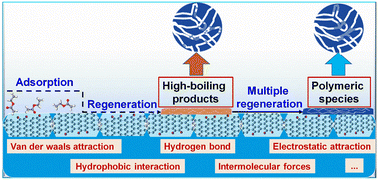Experimental and DFT investigations on adsorption–regeneration performance and deactivation mechanism over engineered carbon fiber: role of pore structure and functional groups†
Abstract
Technology based on adsorption of porous carbon is a promising and cost-effective strategy for the recovery of high-value volatile organic compounds (VOCs) or removal of worthless VOCs. However, the deactivation mechanism of porous carbon adsorbents determined by pore structure and functional groups is not clear. This knowledge gap limits their application in the resource utilization or pollution control of VOCs. We investigated the effect of the pore structure and functional groups in relation to adsorption and regeneration of ethyl acetate (EA) over engineered carbon-fiber adsorbents. Experimental and density functional theory (DFT) results indicated that appropriate basic groups were beneficial for EA adsorption, and the physisorption of micropore structure contributed more to the adsorption capacity. However, the strong chemisorption between EA and adsorbents hampered complete regeneration (only 81.5% capacity retention over six cycles of optimal adsorbents). Semi-quantitative methods and identification of intermediates confirmed that deactivation of porous carbon adsorbents was closely related to EA conversion due to strong chemisorption between EA and the adsorbent interface, which resulted in blockade of the pore structure and occupation of interfacial active sites. Our results may guide the design of highly efficient and economic adsorbents with complex micro-interfaces for recovery of high-value VOC.

- This article is part of the themed collection: Nanomaterials in air


 Please wait while we load your content...
Please wait while we load your content...